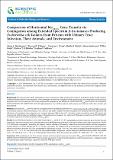Files in this item
Comparison of horizontal blaCTX-M gene transfer via conjugation among extended spectrum β-lactamases producing Escherichia coli isolates from patients with urinary tract infection, their animals and environment
Item metadata
| dc.contributor.author | Mwakyoma, Adam A. | |
| dc.contributor.author | Kidenya, Benson R. | |
| dc.contributor.author | Minja, Caroline A. | |
| dc.contributor.author | Mushi, Martha F. | |
| dc.contributor.author | Sandeman, Alison | |
| dc.contributor.author | Sabiti, Wilber | |
| dc.contributor.author | Holden, Mathew T. G | |
| dc.contributor.author | Mshana, Stephen E. | |
| dc.date.accessioned | 2023-05-31T16:30:10Z | |
| dc.date.available | 2023-05-31T16:30:10Z | |
| dc.date.issued | 2023-05-22 | |
| dc.identifier | 286945073 | |
| dc.identifier | e35a27ac-5cf0-4c43-b149-8ef108c8ad63 | |
| dc.identifier.citation | Mwakyoma , A A , Kidenya , B R , Minja , C A , Mushi , M F , Sandeman , A , Sabiti , W , Holden , M T G & Mshana , S E 2023 , ' Comparison of horizontal bla CTX-M gene transfer via conjugation among extended spectrum β-lactamases producing Escherichia coli isolates from patients with urinary tract infection, their animals and environment ' , Archives of Molecular Biology and Genetics , vol. 2 , no. 1 , pp. 1-8 . https://doi.org/10.33696/genetics.2.011 | en |
| dc.identifier.issn | 2831-6754 | |
| dc.identifier.other | Jisc: 1114191 | |
| dc.identifier.other | ORCID: /0000-0002-4958-2166/work/136288929 | |
| dc.identifier.other | ORCID: /0000-0002-4742-2791/work/136288939 | |
| dc.identifier.other | ORCID: /0009-0005-4229-8129/work/151190572 | |
| dc.identifier.uri | https://hdl.handle.net/10023/27718 | |
| dc.description | Funding: This study was funded by the Holistic Approach to Unravel Antibacterial Resistance in East Africa (HATUA) project funded by the National Institute for Health Research, Medical Research Council and the Department of Health and Social Care, Award (MR/S004785/1). | en |
| dc.description.abstract | Background : The dissemination of the extended spectrum β-lactamases (ESBL) producing E. coli poses a significant public health problem. Understanding the efficiency and frequency of horizontal gene transfer via conjugation of ESBL producing E. coli is imperative towards devising prevention and control measures. This study compared the frequencies and efficiencies of horizontal blaCTX-M gene transfer via conjugation among Escherichia coli isolates from urine and gastrointestinal tract (GIT) of patients with urinary tract infection (UTI), their animals and environment. Methods : Horizontal blaCTX-M gene transfer via conjugation by a broth mating experiment was performed using 50 confirmed ESBL producing E. coli isolates as donors and Escherichia coli J53 (F−, met, pro, Azr), as the recipient. The transconjugants were detected and their frequencies and efficiencies of conjugation were measured and compared between ESBL producing E. coli isolates multi-sourced from urine, GIT, animals and environment. Antimicrobial susceptibility testing of all resulting transconjugants was performed. DNA was extracted from all transconjugants to confirm the presence and the acquisition of blaCTX-M gene. Results : Out of 50 ESBL producing E. coli isolates harboring blaCTX-M gene, 37 (74.0%) successfully exercised horizontal gene transfer through conjugation. All transconjugants were confirmed phenotypically and genotypically by PCR. Of note, all of the isolates from environment 100.0% (7/7) performed conjugation, exhibiting the highest transfer efficiency, followed by isolates from urine and animals, with the conjugation transfer efficiency of 77.8% (14/18) and 76.1% (10/13), respectively. The isolates from the environment conjugated with a significant more efficiency than those from the GIT [Two-sample test of proportions; p-value = 0.0119]. The overall conjugation transfer frequencies ranged from 0.4 × 10-14 – 5.5 × 10-11 per donor cells with the highest median conjugation transfer frequency observed among isolates from animal (3.23 × 10-12 [IQR: 0.70 × 10-12 – 7.22 × 10-12]) followed by that of isolates from the environment (1.60 × 10-12 [IQR: 0.30 × 10-12 – 5.0 × 10-12]). Conclusion : ESBL producing E. coli from human, animals and environment exercises horizontal blaCTX-M gene transfer efficiently with the highest occurrence among isolates from the environment and animals. The antimicrobial resistance control and prevention strategies should be widened up to explore strategies to prevent horizontal AMR gene transfer. | |
| dc.format.extent | 8 | |
| dc.format.extent | 389843 | |
| dc.language.iso | eng | |
| dc.relation.ispartof | Archives of Molecular Biology and Genetics | en |
| dc.subject | Horizontal gene transfer | en |
| dc.subject | Conjugation | en |
| dc.subject | ESBL-producing E. coli blaCTX-M gene | en |
| dc.subject | NDAS | en |
| dc.subject | SDG 3 - Good Health and Well-being | en |
| dc.subject | MCC | en |
| dc.title | Comparison of horizontal blaCTX-M gene transfer via conjugation among extended spectrum β-lactamases producing Escherichia coli isolates from patients with urinary tract infection, their animals and environment | en |
| dc.type | Journal article | en |
| dc.contributor.institution | University of St Andrews. School of Medicine | en |
| dc.contributor.institution | University of St Andrews. St Andrews Bioinformatics Unit | en |
| dc.contributor.institution | University of St Andrews. Infection and Global Health Division | en |
| dc.contributor.institution | University of St Andrews. Biomedical Sciences Research Complex | en |
| dc.identifier.doi | 10.33696/genetics.2.011 | |
| dc.description.status | Peer reviewed | en |
This item appears in the following Collection(s)
Items in the St Andrews Research Repository are protected by copyright, with all rights reserved, unless otherwise indicated.

